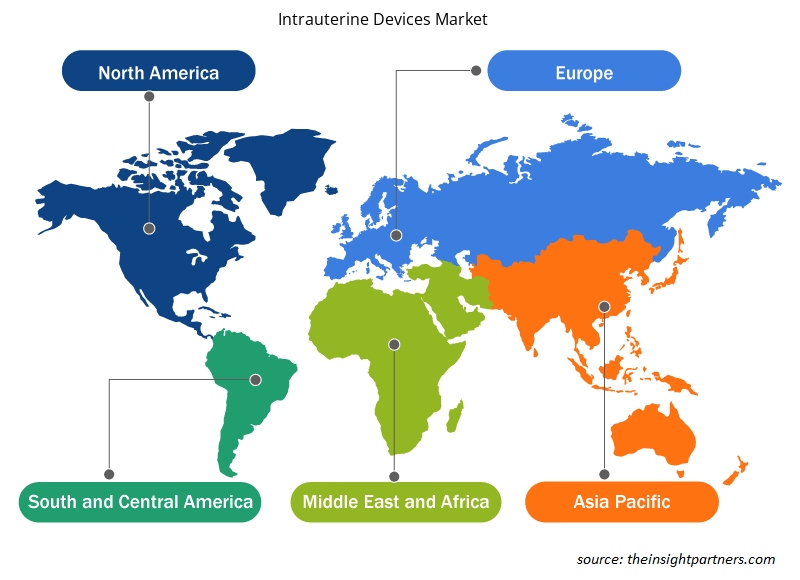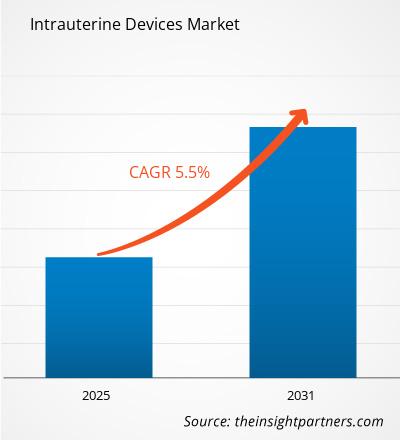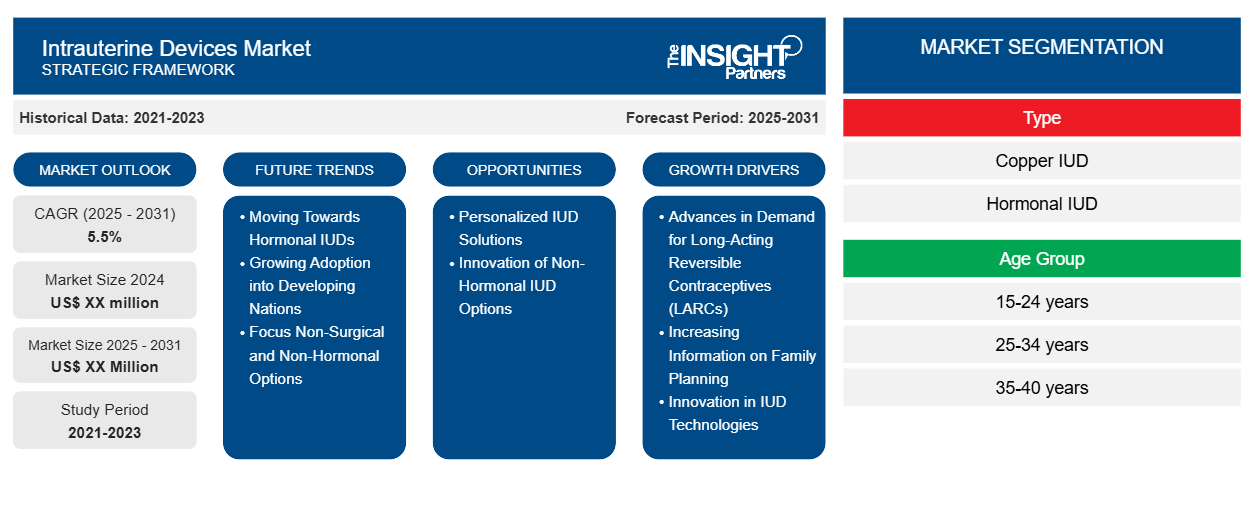宫内节育器市场预计在 2023 年至 2031 年期间的复合年增长率为 5.5%,市场规模将从 2023 年的 XX 百万美元扩大到 2031 年的 XX 百万美元。
报告根据类型(铜制宫内节育器、激素宫内节育器)、年龄组(15-24 岁、25-34 岁、35-40 岁和 40 岁以上)、最终用户(医院、专科诊所等)进行了分析。全球分析进一步细分为区域和主要国家。范围涵盖所有关键细分市场的全球、区域和国家层面的市场规模和预测。报告以美元为单位提供了上述分析和细分市场的价值。报告提供了主要市场参与者的市场状况的关键统计数据,并提供了市场趋势和机会。
报告目的
Insight Partners 发布的《宫内节育器市场》报告旨在描述当前形势和未来增长、主要驱动因素、挑战和机遇。这将为各种业务利益相关者提供见解,例如:
- 技术提供商/制造商:了解不断变化的市场动态并了解潜在的增长机会,从而能够做出明智的战略决策。
- 投资者:对市场增长率、市场财务预测以及整个价值链中存在的机会进行全面的趋势分析。
- 监管机构:监管市场政策和警察活动,旨在最大限度地减少滥用行为,维护投资者的信任和信心,维护市场的完整性和稳定性。
宫内节育器市场细分
类型
- 铜宫内节育器
- 激素宫内节育器
年龄组
- 15-24 岁
- 25-34 岁
- 35-40岁
- 40岁以上
最终用户
- 医院
- 专科诊所
- 其他的
地理
- 北美
- 欧洲
- 亚太
- 南美洲和中美洲
- 中东和非洲
地理
- 北美
- 欧洲
- 亚太
- 南美洲和中美洲
- 中东和非洲
定制此报告以满足您的需求
您可以免费定制任何报告,包括本报告的部分内容、国家级分析、Excel 数据包,以及为初创企业和大学提供优惠和折扣
-
获取此报告的关键市场趋势。这个免费样品将包括数据分析,从市场趋势到估计和预测。
宫内节育器市场增长动力
- 长效可逆避孕药 (LARC) 需求增长:推动宫内节育器市场的主要因素是长效可逆避孕药的普及。如今,女性已不再寻求有效的“一劳永逸”避孕方法,而是更青睐可靠的宫内节育器,因为它无需每日监测。因此,全球范围内永久但可逆的避孕方法的趋势正在增长。
- 增加有关计划生育的信息:对计划生育设备的认识提高,导致人们对宫内节育器的需求和使用越来越感兴趣。公众意识和教育活动以及更好的生殖健康途径使女性选择宫内节育器作为一种安全可靠的避孕方法。在此背景下,作为国际生殖权利运动的一部分,萨沙城市正在推动发展中国家和发展中地区对更多宫内节育器的需求。
- 宫内节育器技术创新:宫内节育器技术创新是推动这一进程的动力。最重要的是,与早期的宫内节育器相比,现代宫内节育器更不令人不适,插入起来也更容易。激素释放型宫内节育器等其他创新的成果具有减少月经出血等其他额外好处,对更多女性具有吸引力,并节省了越来越多的宫内节育器使用者
宫内节育器市场未来趋势
- 转向激素宫内节育器:激素宫内节育器在市场上的受欢迎程度逐渐超过铜制宫内节育器,并且也逐渐流行起来。这种宫内节育器还具有额外的好处,包括月经量减少和痛经减轻,从而吸引了用户。因此,这种趋势正在改变市场动态,女性对避孕的需求不断增加,而避孕对激素健康也有好处。
- 发展中国家的采用率不断提高:宫内节育器市场在发展中国家越来越受欢迎。生殖保健服务的普及率不断提高以及对各种避孕方法的认识不断提高,这些因素使许多发展中国家(如亚洲和非洲)认为宫内节育器相关产品的增长十分有利。政府推出的计划生育举措和大量非政府组织的努力也为使用宫内节育器的人带来了市场的增长,
- 重点关注非手术和非激素选择:非侵入性以及无激素宫内节育器方法(如铜制宫内节育器)的购买热潮明显。这些女性希望获得一种近乎自然的避孕方法。这些设备作为长期避孕药,无需使用激素,非常适合喜欢无激素解决方案的人。它使市场转向寻求真正非侵入性和非激素方法的女性。
宫内节育器市场机会
- 个性化宫内节育器解决方案:宫内节育器在满足个人需求方面存在巨大的融资空间。这些宫内节育器的个性化定制将在很大程度上覆盖上述专业领域,无论是尺寸、材料偏好还是激素含量,从而覆盖更多的女性。因此,会有更多选择,这将鼓励舒适性、有效性和满意度,从而增加不同消费者群体的采用率。
- 非激素宫内节育器选项的创新:随着越来越多的女性采用非激素避孕方法,先进的铜宫内节育器和其他非激素避孕选项的创新和商业化机会正在涌现。因此,随着对非激素避孕的需求不断增长,制造商将有机会在这种对长期、非侵入性避孕方法日益增长的需求中享受更广阔的市场。
宫内节育器市场区域洞察
Insight Partners 的分析师已详尽解释了预测期内影响宫内节育器市场的区域趋势和因素。本节还讨论了北美、欧洲、亚太地区、中东和非洲以及南美和中美洲的宫内节育器市场细分和地理位置。

- 获取宫内节育器市场的区域特定数据
宫内节育器市场报告范围
| 报告属性 | 细节 |
|---|---|
| 2023 年的市场规模 | XX 百万美元 |
| 2031 年市场规模 | XX 百万美元 |
| 全球复合年增长率(2023 - 2031) | 5.5% |
| 史料 | 2021-2022 |
| 预测期 | 2024-2031 |
| 涵盖的领域 |
按类型
|
| 覆盖地区和国家 |
北美
|
| 市场领导者和主要公司简介 |
|
宫内节育器市场参与者密度:了解其对业务动态的影响
宫内节育器市场正在快速增长,这得益于终端用户需求的不断增长,而这些需求又源于消费者偏好的不断变化、技术进步以及对产品优势的认识不断提高。随着需求的增加,企业正在扩大其产品范围,进行创新以满足消费者的需求,并利用新兴趋势,从而进一步推动市场增长。
市场参与者密度是指在特定市场或行业内运营的企业或公司的分布情况。它表明在给定市场空间中,相对于其规模或总市场价值,有多少竞争对手(市场参与者)存在。
在宫内节育器市场运营的主要公司有:
- 阿特维斯
- 拜耳
- 梯瓦制药
- 艾尔建
- ANI 制药公司
免责声明:上面列出的公司没有按照任何特定顺序排列。

- 了解宫内节育器市场的主要参与者概况
主要卖点
- 全面覆盖:报告全面涵盖了宫内节育器市场的产品、服务、类型和最终用户的分析,提供了整体概况。
- 专家分析:报告基于对行业专家和分析师的深入了解而编写。
- 最新信息:该报告涵盖了最新信息和数据趋势,确保了其与业务的相关性。
- 定制选项:此报告可以定制以满足特定客户要求并恰当地适应业务策略。
因此,宫内节育器市场研究报告有助于引领解读和了解行业情景和增长前景。尽管可能存在一些合理的担忧,但本报告的总体优势往往大于劣势。
- 历史分析(2 年)、基准年、预测(7 年)及复合年增长率
- PEST和SWOT分析
- 市场规模、价值/数量 - 全球、区域、国家
- 行业和竞争格局
- Excel 数据集
近期报告
客户评价
购买理由
- 明智的决策
- 了解市场动态
- 竞争分析
- 客户洞察
- 市场预测
- 风险规避
- 战略规划
- 投资论证
- 识别新兴市场
- 优化营销策略
- 提升运营效率
- 顺应监管趋势























 获取免费样品 - 宫内节育器市场
获取免费样品 - 宫内节育器市场